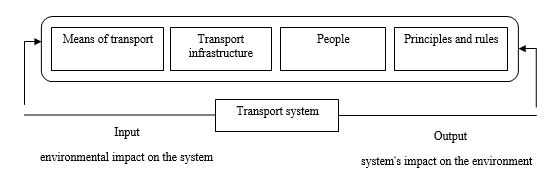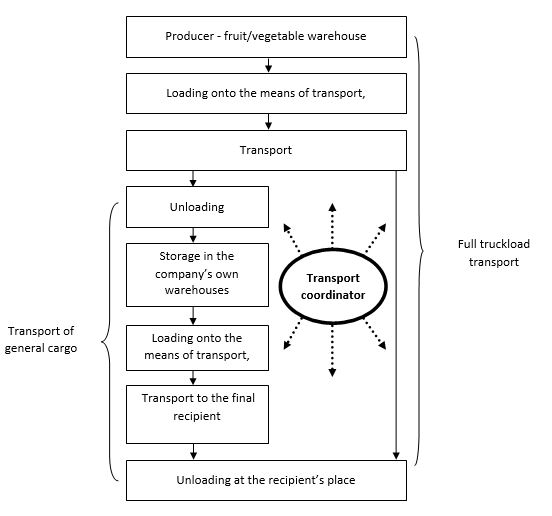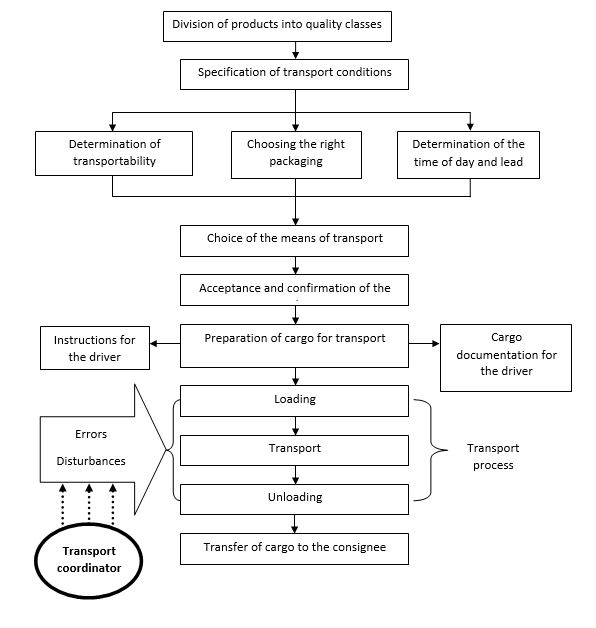Abstract
The paper presents the problems of transport processes based on network structures. The concept of transport and the role it plays in the logistics system were defined. The problems of the transport process together and the components of the transport system were brought close to the reader. The concept of network structures and their advantages in relation to transport management were discussed. The support for transport processes occurs using a model of transport processes with the example of the company providing transport services for the food industry. The model proposes to include a transport coordinator in the transport process to eliminate disruptions to the process and to introduce initiatives that would contribute to the improvement in the process of transport of goods. The practical part analysed the efficiency and effectiveness of transport processes in Company A between 2016 and 2018 based on the historical data made available by the company. The study assessed the customers' satisfaction with the services provided by the company studied, the importance of the organisation's characteristics and the implementation of individual transport processes. Finally, the results of research and analysis were presented with suggestions for improvements.
Keywords: Transport processestransport networksmodelling
Introduction
A characteristic feature of the modern economy is globalization of the production and sales markets in which the growing amount of goods flows through transport networks (Szymczak, 2015). The implementation of transport processes is considered from the standpoint of the dynamically increasing complexity of the transport offer (Banaszyk & Gołembska, 2015); Modelling of modern network structures resulting from the evolution of structures characteristic for the industrial era brings effects in the form of transparent and detailed information on the condition of goods, their availability, conditions of real-time transport. Information processes enable data to be collected, analysed and amended in order to improve the efficiency of transport processes.
Organization of transport networks
In the classical approach, transport is an activity consisting in the movement of persons or goods in space, from the point of departure to the point of arrival, using appropriate resources, and the provision of related ancillary services (Kadłubek, 2018). Transport is present in the entire logistics system, starting from the process of supplying raw materials, materials and semi-finished products for production, to the distribution of finished products (Starostka-Patyk, 2014). The realization of the transport processes is possible with the interaction of a set of elements forming the transport system, consisting of means of transport, transport infrastructure, persons responsible for the functioning of the system, and principles and rules describing the operation of the system (Nowicka-Skowron, Nowakowska-Grunt, & Brzozowska, 2018). Elements of transport in the form of infrastructure, people, means of transport and rules resulting from legal regulations and requirements of counterparties form a transport system presented in Figure

The transport system, and, consequently, the transport process itself, cannot exist without all these components (Aranchiy, Pomaz, & Pomaz, 2016). At the same time, all these elements complement each other and interact with each other, especially in the context of optimization of the transport process.
Transport network management involves the disintegration of a traditional organization, which is replaced by smaller or larger organizations, composed of independent employees or entities (Kawa, 2017). These units are characterized by a high degree of decision-making autonomy, speed and independence of decisions, which results in a higher quality of the product and more efficient management. The advantages of the network structure include: (Światowiec-Szczepańska & Kawa, 2018)
the possibility of achieving high efficiency of transport processes by eliminating unnecessary operations, increasing transport flexibility, introducing new and faster methods of information exchange in order to increase competitiveness and facilitate learning,
the 'network of links' between the entities is conducive to the exchange of resources,
easy control of work and delegating employee's duties,
possibility of achieving the synergy effect (Sułkowski Ł. Sikorski Cz.(2014), Metody zarządzania kulturą organizacyjną, Wydawnictwo Difin, Warsaw, p. 170) ,
high degree of autonomy of the counterparties in the system, which encourages initiatives
presence of a multilateral cooperation effect
Transport companies strive for a networked organization of structures in order to ensure more efficient and effective management of transport processes (Światowiec-Szczepańska & Kawa, 2016) Network management requires a change in the principles, activities and methods used so far (Lis & Ptak, 2018). Changes in personnel are necessary since people with new skills are needed. The appointment of transport coordinators accelerates and empowers decision-making, and to some extent decentralizes management functions while improving the flow of information. Network structures offer opportunities for immediate response to changes or disturbances in the transport process and adjustment of transport services to the customer's requirements and flexible responding to changing needs.
Modelling of transport processes in Company A
The basic approach that is used in the programming of the company's development is modelling (Yıldız & Alpkan, 2015). It is aimed at finding innovative economic, organisational and technical solutions (Tokgöz
Modelling itself is a creative process whose aim is to modify ongoing processes so as to take into account the factors of changes developed earlier in future processes (Jelonek & Stępniak, 2016). The transport process consists of a series of consecutive operations which result in the products being delivered to a specific place, to a specific recipient, and at the right time (Petryczka, Budzik, Szczepańska, & 2017). Modelling of transport processes opens up more opportunities for the analysis and planning of changes in these processes (Cao, Navare, & Jin, 2018).
Modelling of transport processes enables more effective management of this process, which includes the implementation of activities in the field of transport planning, organization and supervision Organizational activities are directly related to the organization of the transport process, e.g. planning of loading and unloading, possible storage, organisation of routes for transport, etc. The executive operations concern directly the transport of goods using appropriate means of transport.
Furthermore, commercial activities include those performed within the framework of commercial services for the transport process, i.e. for shippers and recipients of transported cargo (Gołembska, Bentyn, & Gołembski, 2016).
In the food industry, which is the area of operations of Company A, performance of transport processes plays a very important role because it has a significant impact on the health quality of the transported goods. Therefore, the implementation of this process must comply with the applicable legal regulations, including in particular the requirements of the HCCP system used in all European Union countries, and sanitary requirements relating in particular to the means of transport used to transport vegetables and fruits, as well as the preparation of these loads for transport. The transport processes performed by Company A include organizational, executive and commercial activities. Organizational activities include preparation of transport documents and planning of the transport route. The following executive activities are performed:
loading of fruit and vegetables at the producer's premises,
transport of cargo to the company's warehouses and cold storage chambers,
unloading of transported cargo,
storage,
loading on means of transport,
transportation,
unloading at the recipient’s place.
The enumerated activities can be divided into main and auxiliary activities. The main activities that are always performed by the company as part of its transport processes include:
loading of fruit and vegetables at the producer's premises,
transportation,
unloading at the recipient’s place.
Additional activities are performed if the amounts of cargo delivered by producers are insignificant. Then they are transported to warehouses and cold storage chambers of company A, adequately packaged and then transported to recipients within the combined transport.
Commercial activities performed within the framework of transport processes in Company A include financial settlements with customers. The model of the transport process is illustrated in Fig.

The characteristic feature of the transport processes performed by Company A is their multi-stage character, the mutual interactions between the processes of transport and storage of vegetables and fruits transported by the company, and the adjustment of the means of transport to the size of the order. It is therefore necessary to introduce a transport coordinator to ensure that the transport process runs smoothly. At the same time, this approach is supposed to enable quick and independent decisions to be made while improving the information flow and allowing the coordinator to respond flexibly to the clients’ requirements and needs (Bentyn, 2015).
The organization of the processes of transport of vegetables and fruits offered by the company A involves several stages, as shown in Figure

The most important stages include: division of products according to quality classes, choice of appropriate packaging, storage, determination of the time of day and time of transport, loading, transport, unloading, and invoicing and settlement with consignees. The transport coordinator is supposed to ensure that the transport process runs smoothly by responding with corrective measures to errors, disturbances, and unexpected changes. However, the coordinator can also start initiatives at different stages, affecting the transport process in order to improve its functioning
Analysis of the efficiency and effectiveness of transport process management in the company studied
An important aspect of transport process management in Company A is periodical measurement of the efficiency and effectiveness of the process based on the information collected by the logistics department in the company (Nowicka-Skowron, 2000). To that end, annual data on the number of means of transport available, their annual mileage, number of deliveries, and revenues and costs related to the performance of transport processes are compiled. These data allow for the evaluation of transport processes (Chudzicki, 2016). The presented data concern the period of the last three years of the company's activity, based on which the value of the most important indices of efficiency of transport processes were calculated. Table
The data made available for calculations of the metrics of efficiency and effectiveness of transport performed by Company A are presented in Table
Based on the data presented in Table
Analysis of the data presented in Table
Apart from the ratio analysis, it is important to determine the level of satisfaction among the clients of Company A with the deliveries performed by the company. A survey was conducted in the last quarter of 2018 among 80 recipients of vegetables and fruits transported by Company A. The results of the survey are presented in Table
The survey allowed for identification of the characteristics of deliveries provided by company A which are the most important for the recipients of vegetables and fruits transported by the company. Table
The distribution of the data presented in Table
Analysis of the mean level of satisfaction of the recipients of fruit and vegetables transported by Company A shows that they gave the highest marks to the timeliness of transport processes (4.64), the price of services provided (4.63) and the flexibility of services in the company (4.50). The Customer Satisfaction Index (CSI) as presented in Table
The indicator reached the level of 78%. Although some minor problems with reaching full customer satisfaction were found, the overall result of customer satisfaction is good.
Findings
The analysis of the value of the metrics of efficiency and effectiveness of transport processes performed by Company A in 2016 - 2018 leads to the conclusion that the reliability of transport processes improved and the number of goods damaged during transport decreased. This demonstrates that the efficiency of the transport processes performed by Company A improved. This is also confirmed by the fact that in the analysed period, flexibility of completed transport processes rose, the degree of utilization of means of transport increased by 6.2%, the degree of utilization of working time improved by 2.7%, and the company's delivery readiness increased by 2.5%. On the other hand, the costs of completed transport processes were reduced. It is worth noting that the number of kilometres per means of transport decreased over the three years analysed. Nevertheless, failure rate of the means of transport used by the company increased significantly, by as much as 78%, as a result of the intensity of their utilization and insufficiently frequent technical inspections.
The assessment of the importance of the characteristics of the organization and realization of transport processes in the company analysed revealed that for the recipients of company A, the most important is timeliness (4.90) and price (4.70) of transport processes, and accepting returns (4.64). Furthermore, the evaluation of the mean level of customer satisfaction with the deliveries showed that the recipients gave the highest marks to the timeliness of transport processes (4.64), the price of services provided (4.63) and the flexibility of the services delivered by the company surveyed (4.50).
Conclusion and Discussions
With regard to the analyses conducted in the study, it can be concluded that the introduction of a transport coordinator, as proposed in the transport process implementation model, would improve the transport process due to the capability of:
Early error detection
Immediate and independent decision-making
Introduction of process improvement initiatives such as the purchase of new means of transport
The function of a transport coordinator is consistent with the company’s striving for establishing the network organization of the structures in order to ensure more efficient and effective management of transport processes.
In order to reduce the failure rate of the vehicles in the audited company, it is proposed to:
perform more frequent technical inspections of vehicles equipped with refrigeration systems, most frequently used by the company to transport vegetables and soft fruits,
the purchase of new means of transport equipped with specialized equipment to enable the transport of soft fruit and vegetables over long distances during the summer when temperatures are high,
implementation of changes in the planning of transport routes in order to minimize their length.
References
- Aranchiy, V., Pomaz, O., & Pomaz, J., (2016). The Factors of Influence on the Formation of a Regional Transport Logistic System, Zeszyty Naukowe Politechniki Częstochowskiej Zarządzanie, (21), 7-16.
- Banaszyk, P., & Gołembska, E. (2015). Logistyka w biznesie międzynarodowym [Logistics in international business], Warszawa: WNT.
- Bentyn, Z. (2015). Projekty usprawniania operacji logistycznych dla globalnych sieci dostaw na przykładzie Chin [Projects to improve logistics operations for global supply networks on the example of China], Logistyka, 3, 305-312.
- Cao, L., Navare, J., & Jin, Z. (2018). Business model innovation: How the international retailers rebuild their core business logic in a new host country. International Business Review, 27 (3), 543-562.
- Chudzicki, M., (2016). Analiza opłacalności inwestycji w branży transportowej [Analysis of investment profitability in the transport industry], Zeszyty Naukowe Politechniki Częstochowskiej Zarządzanie 24 (1), 7-16.
- Gołembska, E., Bentyn, Z., & Gołembski, M. (2016). Logistyka w usługach [Logistics in services], Polskie: Wydawnictwo Naukowe.
- Jelonek, D., & Stępniak, C. (2016). Modelowanie procesów biznesowych w kontekście rozwoju kreatywności przyszłych menedżerów [Modeling business processes in the context of developing future managers' creativity], Ekonomika i Organizacja Przedsiębiorstwa, 1, (792), 121.
- Kadłubek, M. (2018). Management Solutions of Transport Companies not Possessing the Unit Dealing with Logistics Customer Service, [w:] New Research Trends in Transport Sustainability and Innovation (red.) Suchanek M., Springer, Cham, pp. 98.
- Kawa, A. (2017). Orientacja sieciowa przedsiębiorstw branży usług logistycznych [Network orientation of logistics services companies], Poznań: Wydawnictwo Uniwersytetu Ekonomicznego w Poznaniu.
- Lis, T., & Ptak, A. (2018). Network Organization - Functioning of Enterprises in the Information Area, Ekonomiczne Problemy Usług, 2 (131), 65.
- Nowicka-Skowron, M. (2000). Efektywność systemów logistycznych [The effectiveness of logistics systems], Warszawa: PWE.
- Nowicka-Skowron, M., Nowakowska-Grunt, J., & Brzozowska, A. (2018). Systemy transportowe a polityka zrównoważonego rozwoju w Unii Europejskiej [Transport systems and the sustainable development policy in the European Union], [in:] Wielowymiarowość zarządzania XXI wieku [Multidimensionality of 21st century management] (red.) Jakubiec M., Barcik A. Wydawnictwo Naukowe Akademii Techniczno-Humanistycznej.
- Petryczka, I., Budzik, A., & Szczepańska, A. (2017). Organizacja procesu transportowego w międzynarodowej wymianie handlowej[Organization of the transport process in international trade exchange] [in:] Wyzwania i perspektywy zarządzania organizacją sieciową. Logistyka w świetle współczesnych badań [Challenges and perspectives of managing a network organization. Logistics in the light of modern research] (red.) NOWAKOWSKA-GRUNT Joanna, MESJASZ-LECH Agata, KOT Sebastian, Wydawnictwo Wydziału Zarządzania Politechniki Częstochowski.
- Stajniak, M., Hajdul, M., Foltyński, M., & Krupa, A. (2008). Transport i spedycja. Instytut Logistyki i Magazynowania, Poznań, 14-15.
- Starostka-Patyk, M., (2014). Zarządzanie procesami transportowymi w przedsiębiorstwach gospodarujących odpadami przemysłowymi [Management of transport processes in enterprises managing industrial waste], Logistyka, 6, 8.
- Szymczak, M. (2015). Ewolucja łańcuchów dostaw [Supply chain evolution], Wydawnictwo Uniwersytetu Ekonomicznego w Poznaniu.
- Światowiec-Szczepańska, J., & Kawa, A. (2016). The impact of network relationships on the competitive advantage in the changing logistics service industry /, 32nd Annual IMP Conference, Poznań Poland.
- Światowiec-Szczepańska, J., & Kawa, A. (2018). Metafory, modele i teorie sieci w naukach o zarządzaniu, Organizacja i Kierowanie Organization and Management, 2, 79-91.
- Tokgöz, A., Bulkan, S., Zaim, S., Delen, D., & Gökhan Torlak, N. (2018). "Modeling airline MRO operations using a systems dynamics approach: A case study of Turkish Airlines". Journal of Quality in Maintenance Engineering, 24(3), 280-310.
- Wolniak, R., & Skotnicka, B. (2008). Wybrane metody badania satysfakcji klienta i oceny dostawców w organizacjach [Selected methods of customer satisfaction survey and supplier evaluation in organizations]. Wydawnictwo Politechniki Śląskiej.
- Yıldız, B., & Alpkan L., (2015) A theoretical model on the proposed predictors of destructive deviant workplace behaviors and the mediator role of alienation. Procedia-Social and Behavioral Sciences 210, 330-338.
Copyright information

This work is licensed under a Creative Commons Attribution-NonCommercial-NoDerivatives 4.0 International License.
About this article
Publication Date
30 October 2019
Article Doi
eBook ISBN
978-1-80296-070-9
Publisher
Future Academy
Volume
71
Print ISBN (optional)
-
Edition Number
1st Edition
Pages
1-460
Subjects
Business, innovation, Strategic management, Leadership, Technology, Sustainability
Cite this article as:
Szczepanik*, T. (2019). Modelling of Transport Processes in the Context of Network Structures. In M. Özşahin (Ed.), Strategic Management in an International Environment: The New Challenges for International Business and Logistics in the Age of Industry 4.0, vol 71. European Proceedings of Social and Behavioural Sciences (pp. 389-401). Future Academy. https://doi.org/10.15405/epsbs.2019.10.02.36
